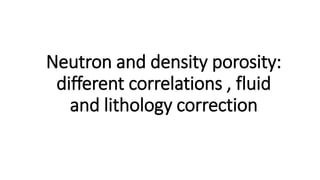
Neutron and density porosity.pptx
- 1. Neutron and density porosity: different correlations , fluid and lithology correction
- 2. PLAN •INTRODUCTION •PRINCIPE DE FONCTIONNEMENT •POROSITY, LITHOLOGY AND NATURE OF FLUID FROM NEUTRON/ DENSITY •UN CAS PRATIQUE AVEC UN LOGS
- 3. INTRODUCTION La diagraphie de la densité mesure la densité des électrons, qui sera transformée en densité apparente. Nous calculons la porosité en supposant la densité de la matrice et la densité du fluide. La diagraphie neutronique mesure le taux de comptage de la roche, ce qui équivaut à la quantité d'hydrogène qu'elle contient. La diagraphie sonique mesure le temps de parcours, ce qui nous permet de calculer la porosité en supposant le temps de parcours de la matrice, le temps de parcours du fluide, la compaction, etc. Je le répète, aucune de ces méthodes ne mesure réellement la porosité, elles mesurent les "propriétés physiques" de la roche en la calibrant en fonction de certains ensembles de normes et d'hypothèses, et calculent ce que pourrait être la porosité sur la base de ces dernières.
- 4. PRINCIPE E FONCTIONNEMENT Le log de densité mesure la densité électronique d'une formation. Le dispositif de diagraphie est un outil de contact qui émet des rayons gamma à partir d'une source. Les rayons gamma émis entrent en collision avec les électrons de formation et se dispersent. Un détecteur, situé à une distance fixe de la source de l'outil, compte le nombre de rayons gamma renvoyés. Le nombre de rayons gamma de retour est un indicateur de la densité apparente de la formation. L'outil de litho-densité (LDT) fournit également une courbe de section efficace des photoélectrons (P e ) , un indicateur indépendant de la lithologie. Le log neutronique mesure principalement la concentration d'hydrogène dans une formation. Le dispositif d'enregistrement est un outil sans contact qui émet des neutrons à partir d'une source. Les neutrons émis entrent en collision avec les noyaux de la formation et perdent une partie de leur énergie. La perte d'énergie maximale se produit lorsque les neutrons émis entrent en collision avec des atomes d'hydrogène, car un neutron et un atome d'hydrogène ont presque la même masse. Par conséquent, la plupart des pertes d'énergie neutronique se produisent dans la partie de la formation qui a la concentration d'hydrogène la plus élevée. La perte d'énergie neutronique peut être liée à la porosité car dans les formations poreuses, l'hydrogène est concentré dans le fluide remplissant les pores. Les réservoirs dont les pores sont remplis de gaz peuvent avoir une porosité plus faible que les mêmes pores remplis d'huile ou d'eau car le gaz a une plus faible concentration d'atomes d'hydrogène que l'huile ou l'eau.
- 5. Density log The density log measures the electron density of a formation. The logging device is a contact tool that emits gamma rays from a source. Emitted gamma rays collide with formation electrons and scatter. A detector, located a fixed distance from the tool source, counts the number of returning gamma rays. The number of returning gamma rays is an indicator of formation bulk density. The litho-density tool (LDT) also provides a photoelectron (Pe) cross section curve, an independent indicator of lithology.
- 6. Obtaining porosities from a density log Formation bulk density is a function of matrix density, porosity, and fluids contained in the pore space. Formation bulk density measured by the log must be corrected for borehole irregularities. Convert bulk density to porosity using charts in a log interpretation chartbook, or calculate porosity from bulk density using this equation:
- 7. Neutron log The neutron log mainly measures hydrogen concentration in a formation. The logging device is a noncontact tool that emits neutrons from a source. Emitted neutrons collide with nuclei of the formation and lose some of their energy. Maximum energy loss occurs when emitted neutrons collide with hydrogen atoms because a neutron and a hydrogen atom have almost the same mass. Therefore, most neutron energy loss occurs in the part of the formation that has the highest hydrogen concentration. Neutron energy loss can be related to porosity because in porous formations, hydrogen is concentrated in the fluid filling the pores. Reservoirs whose pores are gas filled may have a lower porosity than the same pores filled with oil or water because gas has a lower concentration of hydrogen atoms than either oil or water.
- 8. Obtaining porosities from a neutron log Lithology, porosity, fluid type, and tool type affect neutron log response. When interpreting neutron logs, use the specific log for the specific tool, i.e., the charts in logging chart books that are specific to the sidewall neutron log (SNP) or the compensated neutron log (CNL). To obtain porosity, read the value directly from the log. If the log is recorded in limestone units and the formation you wish to evaluate is sandstone or dolomite, then correct the log value by using the appropriate chart in a log interpretation chartbook.
- 9. Combination density–neutron logs The density–neutron log is a combination log that simultaneously records neutron and density porosity. In some zones, porosities recorded on the logs differ for three reasons: The matrix density used by the logging program to calculate porosity is different from the actual formation matrix density. Gas is present in the formation pore space. Shale/clay is present in the formation.
- 10. DETERMINATION DE LA POROSITE, LITHOLOGIE & NATURE DU FLUIDE A PARTIR DES LOGS NEUTRON/DENSITY